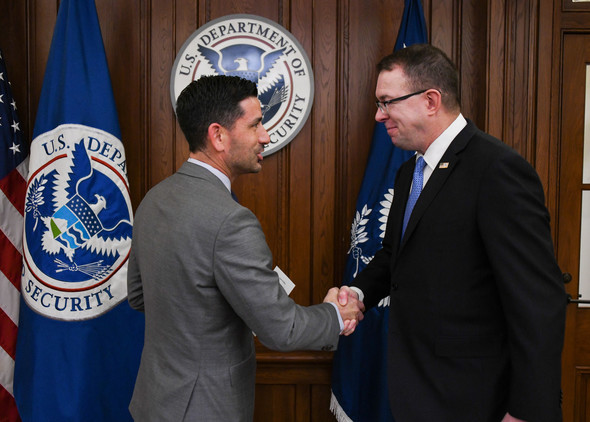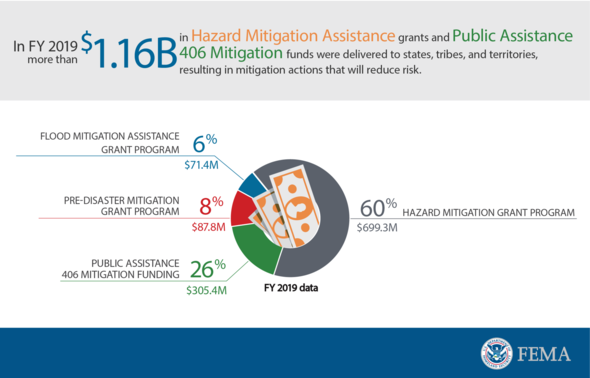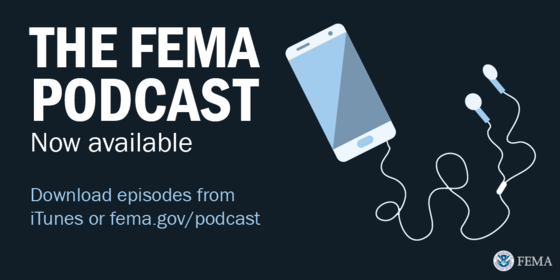|
On Jan. 16, Acting Homeland Security Secretary Chad Wolf swore in Pete Gaynor as the new FEMA Administrator. Administrator Gaynor came to FEMA in October 2018, having served in emergency management roles at the local, state and federal agencies as well as throughout his military career.
As FEMA’s Acting Administrator since March 2019, Gaynor has led FEMA in its mission to help people before, during and after disaster and spearheaded accomplishment of the agency’s 2018-2022 Strategic Plan. He has provided leadership to the successful implementation of many provisions of the Disaster Recovery Reform Act (DRRA) of 2018 and was the driving force behind “Pub 1: We Are FEMA.”
Administrator Gaynor continues to champion an inclusive work environment, provide direction, and transform the field of emergency management with the implementation of critical reforms.
 Acting Homeland Security Secretary Chad Wolf (Left) swore in Pete Gaynor as the new FEMA Administrator on Feb. 16.
FEMA is updating the statewide per capita indicator that recommends cost-share adjustment for Public Assistance Programs.
This adjustment is based on an increase of 2.3 percent in the Consumer Price Index for All Urban Consumers for the 12-month period that ended December 2019. The Consumer Price Index was released by the Bureau of Labor Statistics on Jan. 14.
FEMA will recommend an increase in the standard 75 percent Federal cost share to not more than 90 percent of eligible costs when a disaster is so extraordinary that actual Federal obligations under the Stafford Act, excluding FEMA administrative costs, meet or exceed $149 per capita of state or tribal population.
This applies to all disasters declared on or after Jan. 1, 2020, through Dec. 31, 2020. For additional information about these adjustments, review the notices on the Federal Register.
In 2019, FEMA funded more than $1.16 billion in Hazard Mitigation Assistance grants. This included these top five project types:
-
Flood Control: $148 million was granted to flood-risk reduction projects such as dikes, levees, floodwalls and erosion projects that are cost-effective, feasible and designed to reduce risk.
-
Acquisitions: $132 million was granted to communities to acquire or buy properties from homeowners and demolish or relocate any structures on the property.
-
Utility and Infrastructure Protection: $112 million was granted to fund projects that reduce risk to existing utility systems, roads, and bridges such as seismic retrofits to strengthen buildings against earthquakes and burying utility lines to protect them from high-wind events such as hurricanes.
-
Generators: $73 million was granted for the purchase and installation of generators for the protection of critical facilities.
-
Safe Rooms/Wind Shelters: $67 million was granted for safe rooms that are designed and constructed either in community spaces such as schools or community buildings. These rooms provide protection during extreme weather events such as tornadoes and hurricanes.
By design, the Hazard Mitigation Grant Program helps communities implement hazard mitigation measures following a Presidential Major Disaster Declaration requested by the Governor or Tribal Executive. This grant program also enacts mitigation measures to reduce the risk of loss of life and property from future disasters.

Today, FEMA released Dr. Carolyn Kousky’s PrepTalk “Harnessing the Power of Disaster Insurance,” identifying the essential role of insurance in disaster recovery. Kousk offers suggestions for how the public and private sectors can work together to overcome the challenges of increasing insurance coverage across America.
Kousky is Executive Director of the Wharton Risk Management and Decision Processes Center at the University of Pennsylvania. Through her research, she has examined multiple aspects of disaster insurance markets, the National Flood Insurance Program, federal disaster aid, and policy responses to potential changes in extreme events.
PrepTalks are a partnership between FEMA, the International Association of Emergency Managers, the National Emergency Management Association, the National Homeland Security Consortium, and the Naval Postgraduate School Center for Homeland Defense and Security. The PrepTalk video and additional resources are available on the FEMA website.
The application deadline for the 2019 Flood Mitigation Assistance and Pre-Disaster Mitigation grants is 3 p.m. on Jan. 31. All eligible applicants must submit completed materials by 3 p.m. on the FEMA Mitigation eGrants system on the FEMA Grants Portal.
Anyone experiencing a problem in submitting an application should contact the eGrants support team as soon as possible to ensure your grant is submitted smoothly and on time. System-related issues will be addressed up to 3 p.m. ET on Jan. 29, 2020. No new system-related issues will be addressed after this time.
Visit the eGrants Reference Tools for a list of fixes for bugs and small issues. Contact the eGrants support team for help resolving system issues.
FEMA is hosting three webinars for the Nonprofit Security Grant Program (NSGP). The grant program provides funding support for physical security enhancements to nonprofit organizations and promotes emergency preparedness coordination and collaboration between public and private community representatives as well as state and local government agencies.
Each webinar will present the same content, including an overview of the NSGP, information on grant program eligibility and allowable costs, and a moderated question and answer session.
Webinars will be held 2:30 p.m. ET on Jan. 22, Jan. 30, and Feb. 4.
To Participate:
Dial in 15 minutes before the start of the call and provide your name and organization to the operator when calling in. If you are unable to join the webinar or the call, that means it has reached capacity and you should plan on attending the next event.
If you have any questions regarding these webinars, please contact FEMA’s Grant Programs Directorate Information Desk at 1-800-368-6498. Visit the FEMA website for more information on the NSGP.
FEMA Released Ready Campaign's 2020 Preparedness Calendar
Last month, FEMA released the Ready Campaign's 2020 Preparedness Calendar. The calendar identifies year-round opportunities to promote individual preparedness and is one component of FEMA’s commitment to building a culture of preparedness. The calendar promotes the resources necessary for stakeholders to customize emergency preparedness campaigns and messaging to raise awareness and includes monthly preparedness activities and links to associated educational materials and toolkits.
As Ready partners play a critical role in increasing awareness by spreading the word about emergency preparedness, please download the calendar in English and in Spanish and check out the materials to support your preparedness communications.
On this episode, listen to a discussion with National IMAT Lead Tito Hernandez and Regional IMAT Lead Keith Denning. They discuss the unique nature of Incident Management Assistance Teams from both the national and regional perspective.
The FEMA podcast is an audio program series available to anyone interested in learning more about the agency, hearing about innovation in the field of emergency management, and listening to stories about communities and individuals recovering after disasters.

|